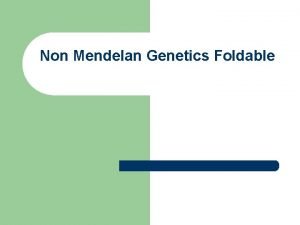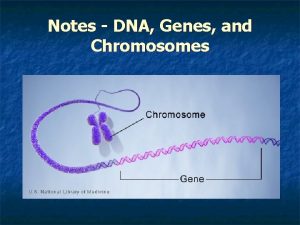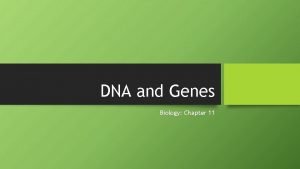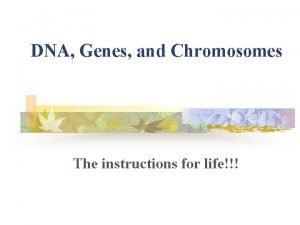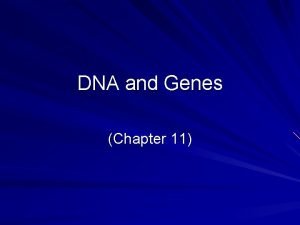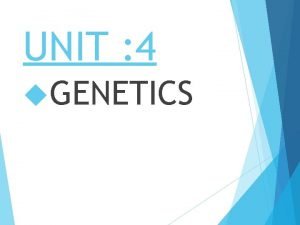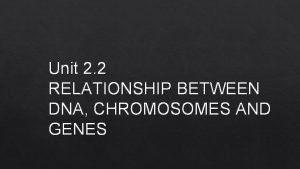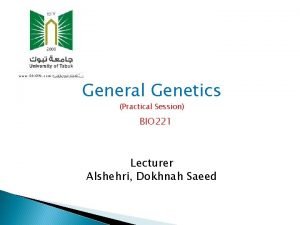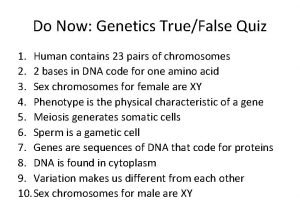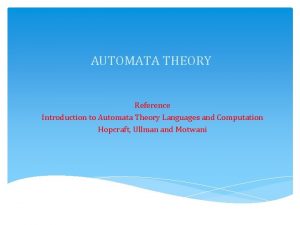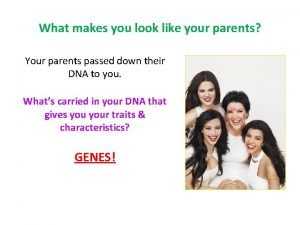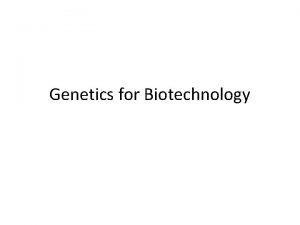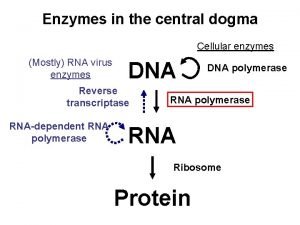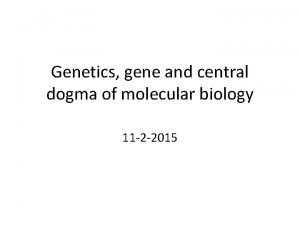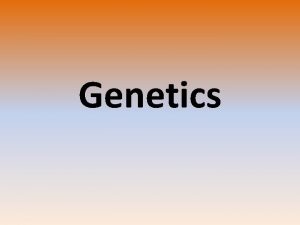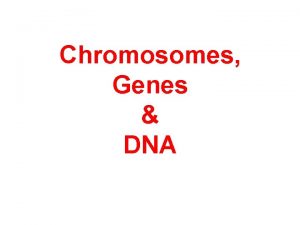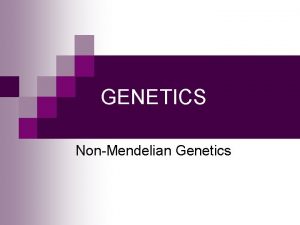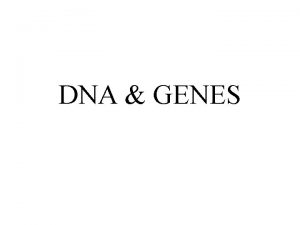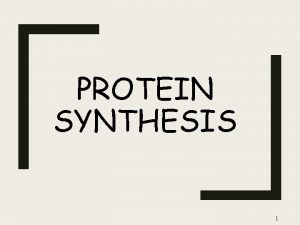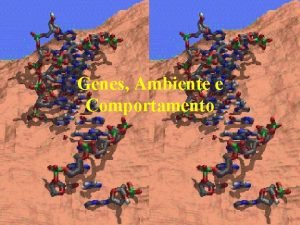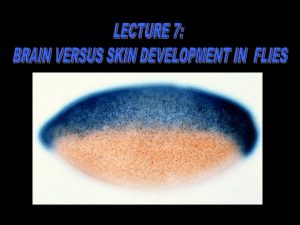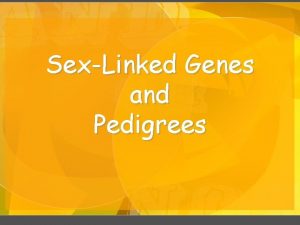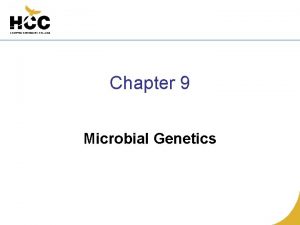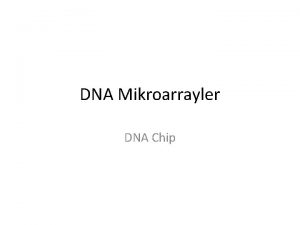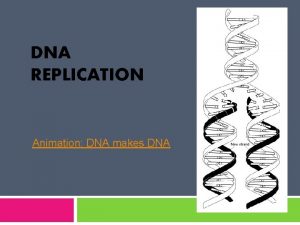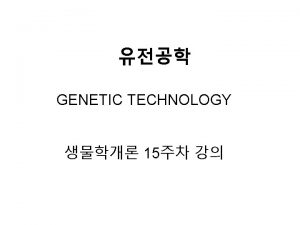Genetics DNA Genetics Central Concepts Genes allow for





















































- Slides: 53

Genetics & DNA Genetics Central Concepts: Genes allow for the storage and transmission of genetic information. They are a set of instructions encoded in the nucleotide sequence of each organism. Genes code for the specific sequences of amino acids that comprise the proteins characteristic to that organism.



ACTIVATOR: Complete the Vocab on page 277. Section 10. 2 Mendelian Genetics WORD DEFINITION Law of Segregation ____________________________________________________________ Hybrid ____________________________________________________________ Law of Independent Assortment ____________________________________________________________

GENETICS is the branch of biology that deals with inheritance.

Do you see any characteristics that these children share with their parents or their brothers and sisters?

DNA (Deoxyribonucleic Acid)

Genetic material of cells… • GENES – units of genetic material that CODES FOR A SPECIFIC TRAIT • Called NUCLEIC ACIDS • DNA is made up of repeating molecules called NUCLEOTIDES

DNA is the genetic material that is passed from generation to generation. Cells -> Nucleus –> Chromosomes –> Gene –> Trait BIGGEST----------------- smallest

A HISTORY OF DNA • Discovery of the DNA double helix A. Frederick Griffith – Discovers that a factor in diseased bacteria can transform harmless bacteria into deadly bacteria (1928) B. Rosalind Franklin - X-ray photo of DNA. (1952) C. Watson and Crick - described the DNA molecule from Franklin’s X-ray. (1953)

Watson & Crick proposed… • DNA had specific pairing between the nitrogen bases: ADENINE – THYMINE CYTOSINE - GUANINE • DNA was made of 2 long stands of nucleotides arranged in a specific way called the “Complementary Rule”

What is DNA? • Although the environment influences how an organism develops, the genetic information that is held in the molecules of DNA ultimately determines an organism’s traits. • DNA achieves its control by determining the structure of proteins. • Within the structure of DNA is the information for life—the complete instructions for manufacturing all the proteins for an organism.

Each nucleotide has three parts: sugar, phosphate, nitrogenous base • Watson and Crick also proposed that • DNA is shaped like a long zipper that is twisted into a coil like a spring.

DNA is shped in a Double Helix 5 O 3 3 P 5 O O C G 1 P 5 3 2 4 4 2 3 P 1 T 5 A 3 P O O P 5 O 3 5 P

There are four different nitrogenous bases found in DNA: adenine (A), cytosine (C), guanine (G), and thymine (T).

Chargaff’s Rule • Adenine must pair with Thymine • Guanine must pair with Cytosine • Their amounts in a given DNA molecule will be about the same T A G C

The four nitrogenous bases of DNA nucleotides bond together in only one way: DNA -> DNA (A) pairs with (T), (C) pairs with (G). Air goes in Tires Gas goes in Cars

Genetic Diversity… • Different arrangements of NUCLEOTIDES in a nucleic acid (DNA) provides the key to DIVERSITY among living organisms.

The Code of Life… • The “code” of the chromosome is the SPECIFIC ORDER that bases occur. A T C G T A T G C G G…

Hydrogen bonds hold the two strands together between the bases.



Replication Quiz 1. What is DNA? 2. When does replication occur? 3. Describe how replication works. 4. Use the complementary rule to create the complementary strand: A---___ G---__ C--___ T---__ A---__ G---__ C---__ A---__ G---__ T---__

DNA REPLICATION – When DNA copies itself DNA can be used as the hereditary material because it can make identical copies of itself.

THE #1 Thing to Remember is the DNA MAKES PROTEINS! DNA Replication

The DNA controls cellular activities by providing instructions for PROTEIN SYNTHESIS. It happens in 2 Steps

DNA ->m. RNA A -> U T -> A C <-> G REMEMBER: when you transcribe DNA code to RNA code, use U in place of T.

MESSENGER RNA (m. RNA) carries the DNA code to the ribosome for protein synthesis. m. RNA is formed by copying DNA as a pattern or TEMPLATE in a process called TRANSCRIPTION.



PRACTICE TRANSCRIPTION If the DNA code reads : AGCTGTACA Then the m. RNA strand would read : UCGACAUGU REMEMBER: when you transcribe DNA code to RNA code, use U in place of T.

m. RNA molecules are read three bases at a time. Each three base sequence is called a CODON.

TRANSFER RNA (t. RNA) carries amino acids to the ribosomes for protein synthesis Click here to see it in action Protein Synthesis This process is called TRANSLATION.



DNA Transcribed RNA Translated Proteins


Each CODON represents one of the 20 amino acids, or START or STOP.


In SUMMARY: PROTEIN SYNTHESIS requires two steps: TRANSCRIPTION (DNA m. RNA) and TRANSLATION (m. RNA polypeptide) Polypeptide is a chain of amino acids that when folded up make a Protein

What polypeptide would be formed from this DNA strand? ? TACTTCAAAATC AUGAAGUUUUAG met-lys-phe


Any change in the sequence of nucleotides in a DNA molecule is a GENE MUTATION. The mutation may result in changes that affect the structure and function of the protein made by that gene. A single mutation of the hemoglobin gene causes sickle cell anemia.

Sickle cell anemia • Hemoglobin protein in red blood cells – strikes 1 out of 400 African Americans – limits activity, painful & may die young Normal round cells Misshapen sickle cells Only 1 out of 146 amino acids

POINT MUTATION A single base change in the DNA sequence. The effect of the mutation varies from no effect at all to a mutation that can cause a serious disease. A mutation that affects the third position of the m. RNA codon has the least effect on the production of a particular protein.

Point Mutations • One base change – can change the meaning of the whole protein THEFATCATANDTHEREDRATRAN THEFATCARANDTHEREDRATRAN OR THEFATCATENDTHEREDRATRAN Does this change the sentence? A LITTLE!


FRAME SHIFT MUTATION A single base is either added to or deleted from the DNA sequence. The mutation affects every codon after the location of the mutation. Very serious effects. Causes a completely different amino acid chain to be produced.


Although mutations occur spontaneously, the rate of mutation can be increased by exposure to MUTAGENIC AGENTS. X rays, ultraviolet rays, radioactive substances, and cosmic rays are mutagenic agents. Mutagenic chemicals include formaldehyde, benzene, and asbestos fibers.

Mutations may be transmitted to the next generation ONLY if they are present in the gametes. Mutations in body cells may be passed on to new cells of the individual as a result of mitosis, but will NOT be transmitted to the offspring.


GEL ELECTROPHORESIS – “DNA fingerprinting” Uses RESTRICTION ENZYMES to cut DNA into pieces Then SORTS OUT the DNA by SIZE. You can COMPARE the banding patterns produced by the DNA piles to determine the relationships between specimens.
 Linked genes and unlinked genes
Linked genes and unlinked genes Factors of 15
Factors of 15 Polygenic inheritance
Polygenic inheritance Chromosomes genes and basic genetics foldable answer key
Chromosomes genes and basic genetics foldable answer key The relationship between genes dna and chromosomes
The relationship between genes dna and chromosomes Chapter 11 dna and genes
Chapter 11 dna and genes Dna, genes and chromosomes relationship
Dna, genes and chromosomes relationship Dna and genes chapter 11
Dna and genes chapter 11 Genes chromosome
Genes chromosome What is the relationship between dna chromosomes and genes
What is the relationship between dna chromosomes and genes What is a gene
What is a gene Dna genes
Dna genes Dna chromosomes genes diagram
Dna chromosomes genes diagram Dna rna protein synthesis homework #2 dna replication
Dna rna protein synthesis homework #2 dna replication Human genetics concepts and applications 10th edition
Human genetics concepts and applications 10th edition Chapter 12 section 1 dna the genetic material
Chapter 12 section 1 dna the genetic material Replication
Replication Bioflix activity dna replication nucleotide pairing
Bioflix activity dna replication nucleotide pairing Coding dna and non coding dna
Coding dna and non coding dna What role does dna polymerase play in copying dna?
What role does dna polymerase play in copying dna? Definition of a concept paper
Definition of a concept paper Central concepts of automata theory in flat
Central concepts of automata theory in flat Que es
Que es Central dogma
Central dogma Dna central dogma
Dna central dogma Dna central dogma
Dna central dogma Formuö
Formuö Novell typiska drag
Novell typiska drag Tack för att ni lyssnade bild
Tack för att ni lyssnade bild Returpilarna
Returpilarna Varför kallas perioden 1918-1939 för mellankrigstiden
Varför kallas perioden 1918-1939 för mellankrigstiden En lathund för arbete med kontinuitetshantering
En lathund för arbete med kontinuitetshantering Kassaregister ideell förening
Kassaregister ideell förening Tidbok yrkesförare
Tidbok yrkesförare Sura för anatom
Sura för anatom Vad är densitet
Vad är densitet Datorkunskap för nybörjare
Datorkunskap för nybörjare Tack för att ni lyssnade bild
Tack för att ni lyssnade bild Tes debattartikel
Tes debattartikel Delegerande ledarskap
Delegerande ledarskap Nyckelkompetenser för livslångt lärande
Nyckelkompetenser för livslångt lärande Påbyggnader för flakfordon
Påbyggnader för flakfordon Tryck formel
Tryck formel Svenskt ramverk för digital samverkan
Svenskt ramverk för digital samverkan Jag har nigit för nymånens skära
Jag har nigit för nymånens skära Presentera för publik crossboss
Presentera för publik crossboss Jiddisch
Jiddisch Kanaans land
Kanaans land Treserva lathund
Treserva lathund Fimbrietratt
Fimbrietratt Bästa kameran för astrofoto
Bästa kameran för astrofoto Centrum för kunskap och säkerhet
Centrum för kunskap och säkerhet Byggprocessen steg för steg
Byggprocessen steg för steg Mat för idrottare
Mat för idrottare



